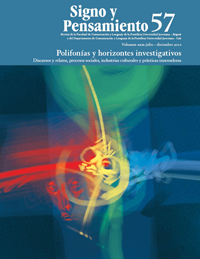Abstract
After examining some recent publications from very different parts of the world on the much needed conceptual and practical renovation of research on communications, we propose a reflection on the Latin American conditions in order to take on the implications of what is known as the “centrality of communications” and reorganizing academic structures, but having in mind a better defined orientation vis-à-vis relevant social “goals” in order to counteract some dangerous trends such as what we can call “shallow immediatism” or “technologism” when studying media and communications.
Beltrán, L. R.; Suárez, C., y Isaza, G. (1990), Bibliografía de estudios sobre comunicación en Bolivia, La Paz, proinsa/idrc.
Brier, S. (2008), Cibersemiotics. Why Information is Not Enough!, Toronto, Buffalo, Londres, University of Toronto Press.
Carey, J. W. (1989), Communication as Culture. Essays on Media and Society, Nueva York, Londres, Routledge.
Castells, M. (2009), Communication Power, Oxford, New York, Oxford University Press.
Craig, R. T. (1989), “Communication as a practical discipline”, en Dervin, G.; O’Keffe, y Wartella (eds.), Rethinking Communication. Volume I: Paradigm Issues, Newbury Park, CA, Sage, pp. 97-122.
— (1999), “Communication Theory as a Field”, Communication Theory, núm. 9, pp. 119-161.
— (2008a), “Communication as a Field and Discipline”, en Donsbach (ed.), The International Encyclopedia of Communication, Nueva York, Blackwell, vol. ii, pp. 675-688.
— (2008b), “Communication in the Conversation of Disciplines”, Russian Journal of Communication, vol. 1, núm. 1, pp. 7-23.
Donsbach, W. (2006), “The identity of Communication Research”, Journal of Communication, vol. 56, núm. 3, pp. 437-448.
— (ed.) (2008), The International Encyclopedia of Communication, Nueva York, Blackwell.
Fuentes Navarro, R. (1988), La investigación de comunicación en México. Sistematización documental 1956 1986, México, Ediciones de Comunicación.
— (2008), La comunicación desde una perspectiva sociocultural. Acercamientos y provocaciones 1997-2007, Guadalajara, iteso.
— (s. f.), “Medio siglo del estudio universitario de la comunicación en México: el riesgo del inmediatismo superficial”, Anuario de Investigación de la Comunicación xvii [en prensa], México, Consejo Nacional para la Enseñanza y la Investigación de las Ciencias de la Comunicación.
Giddens, A. (1984), The Constitution of Society: Outline of the Theory of Structuration, Berkeley/Los Angeles, University of California Press.
Herkman, J. (2008), “Current Trends in Media Research”, Nordicom Review, vol. 29, núm. 1, Göteborg, Nordicom, pp. 145-159.
Jensen, K. B. (1995), The Social Semiotics of Mass Communication, Londres, Sage.
— (ed.) (2002), A Handbook of Media and Communication Research. Qualitative and Quantitative Methodologies, Londres, Nueva York, Routledge.
— (2010), Media Convergence. The Three Degrees of Network, Mass, And Interpersonal Communication, Londres, Nueva York, Routledge.
Marques de Melo, J. (coord.) (1984), Inventário da pesquisa em Comunicação no Brasil 1883 1983, São Paulo, intercom/alaic.
Martín-Barbero, J. (2002), Oficio de cartógrafo. Travesías latinoamericanas de la comunicación en la cultura, Santiago de Chile, Fondo de Cultura Económica.
— (coord.) (2009), Entre saberes desechables y saberes indispensables (agendas de país desde la comunicación), Bogotá, Centro de Competencia en Comunicación para América Latina, Friedrich Ebert Stiftung.
Munizaga, G. y Rivera, A. (1983), La investigación en comunicación social en Chile, Lima, desco/ Ceneca.
Nordenstreng, K. (2007), “Discipline or Field? Soul-serching in Communication Research”, Carlsson y Helland (eds.), Media Structures and Practices. As Time Goes by… Studies and Reflections from a Scandinavian Horizon, Göteborg, Nordicom Review Jubilee Issue, pp. 211-222.
Peirano, L. y Kudo, T. (1982), La investigación en comunicación social en el Perú, Lima, desco.
Peters, J. D. (1999), Speaking into the Air. A History of the Idea of Communication, Chicago, Londres, The University of Chicago Press.
Rivera, J. B. (1986), La Investigación en comunicación social en Argentina, Lima, desco/asaicc.
This journal is registered under a Creative Commons Attribution 4.0 International Public License. Thus, this work may be reproduced, distributed, and publicly shared in digital format, as long as the names of the authors and Pontificia Universidad Javeriana are acknowledged. Others are allowed to quote, adapt, transform, auto-archive, republish, and create based on this material, for any purpose (even commercial ones), provided the authorship is duly acknowledged, a link to the original work is provided, and it is specified if changes have been made. Pontificia Universidad Javeriana does not hold the rights of published works and the authors are solely responsible for the contents of their works; they keep the moral, intellectual, privacy, and publicity rights.
Approving the intervention of the work (review, copy-editing, translation, layout) and the following outreach, are granted through an use license and not through an assignment of rights. This means the journal and Pontificia Universidad Javeriana cannot be held responsible for any ethical malpractice by the authors. As a consequence of the protection granted by the use license, the journal is not required to publish recantations or modify information already published, unless the errata stems from the editorial management process. Publishing contents in this journal does not generate royalties for contributors.


